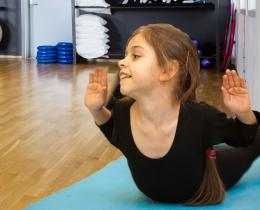Traci Childress, codirector of the Children’s Community School in West Philadelphia, shares mindfulness practices she integrates into the school's curriculum and practices with her two young children.
Mindfulness, simply defined, is returning to the moment. It is a practice that uses simple tools to help you notice your breath, your body, your sensations, what is happening around you, and what others are experiencing. As you develop practices of noticing, you become more able to return to the moment, and connect to yourself and others more deeply.
You can teach kids how to be mindful with these five easy and fun mindfulness practices for children. And, if you’re new to mindfulness, you can learn right along with them.
1. Build Relationship With Breath & Breathing
Connecting the rhythm of the breath to experience helps children gain an understanding of the central nervous system and how to calm it down, without having to discuss the physiology of it (though older or inquisitive children might enjoy studying how breathing actually works).You can begin by asking children to notice their breath. With younger children, you might need to introduce them to the breath. Invite them to put a hand in front of their nose and breathe. Tell them, “This is breath. All living things breathe.” Invite them to share what they experience.
You can then model your breath in relation to experiences and feelings you have. For example, “I feel so frustrated and my breath is moving fast. Look at my chest.” Then you can model returning to calm breath. “I am putting my hand on my chest and taking longer breaths.”
Next, you can help children notice how their breath changes throughout the day. Try using these games to help children build an understanding and relationship with their breath:
- Ask the child to lie down and be very still with their hands on their chest and belly. Ask them to notice the breath. Then ask them to stand up and move fast, then notice the breath once again.
- Observe their breath throughout the day. After hard play, you might say, “Your breath is moving so fast. You were running hard!” At bedtime, you might say, “Your breath is getting sleepy and slow!” Remember to be a witness, not a judge.
- Play is an excellent way to discover the breath. Ask the child to make noises with their breath, such as breathing like a lion or snake. You can also invite them to try to sustain a sound, such as chanting a vowel sound, and timing them to see how long they can do it.
2. Notice Feelings & Body Sensations
Create a daily or regular mind-body check-in practice for kids. In the morning, have a feelings check-in. At breakfast, or before brushing teeth, ask, “What are you feeling today?” The idea is not to change or fix anything, just to notice. For example, you might say “Feeling check-in time! Today I am feeling tired and excited. What about you?” Be sure to allow a broad perspective. Children might be able to name their feelings, or they may be able to name only the sensation they’re feeling—buzzy, weak, jumpy, floppy, etc. Invite it all.
3. Cultivate Sensory Awareness of the World
Paying attention to sensations can bring children, and you, into the moment. Integrate sensory awareness into your daily life with simple questions like, “What do you see? What do you hear? What do you smell?” You can bring this practice with you everywhere—in the waiting room at the dentist, in the car, on the train, and on the plane. It allows you all to practice noticing what is happening around you in the present moment.
4. Practice Moments of Quiet
Intentionally quiet moments support the development of mindfulness and empower children to consider “not doing” a valid part of everyday life. Children in our culture are not often invited to quiet moments. We tend to fill their extra time with activity. Yet, when given the chance to be quiet, kids love it! When I practice yoga, both of my children join me for the sitting meditation at the start and end.
Try this “quiet” exercise: Ask the child to get so quiet that they can hear a particular sound in the room—their breath, the tick of a clock, the hum of a computer, etc. Once they hear it, and you do, too, you can dismiss the practice with a bell, a gentle clap, or some other soft sound.
5. Send Well Wishes to Others
The traditional Buddhist practice of mettha, or lovingkindness meditation, invites you to recite phrases or wishes that you direct, first to yourself, then outward toward others. For example, “May I be safe. May I be well. May I be at peace.” Then, you repeat the same phrases for someone you love, someone you don’t know but see regularly, and ultimately all beings.
This is one of the mindfulness practices for children I introduced when my oldest son became curious about ambulances. We live in the city so we often hear sirens. I told him, “Emergency rescue workers are helpers. Their sirens mean they are going to help someone. When we hear the sirens, we can wish them and those they are going to help well by saying, ‘May they be safe.’”
My son is now five and I often hear him say, “May they be safe,” at the sound of sirens.



